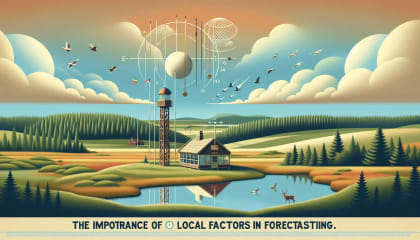The Importance of Local Factors in Forecasting
Discover the critical role local factors play in weather forecasting. Understand how elements like topography, urbanization, and microclimates influence accurate predictions and how expertly interpreting these nuances can enhance daily life.
In a world where we increasingly rely on technology, local factors in weather forecasting are often overlooked. However, ignoring these nuances is a grave mistake. As a dedicated meteorologist and the voice behind Optic Weather, I can confidently tell you: local factors can make or break your weather forecast.
Think about it—what happens when a forecast doesn’t match what you experience outside? Chances are, it’s because the forecast didn’t account for specific local factors. Today, we’ll explore why these elements are so crucial, examine various local influences like topography and urbanization, and discuss how understanding them can drastically improve your daily life.
Understanding Local Weather Influences
- Topography
- Mountains and Valleys
- Mountains can act as barriers, blocking certain weather systems and causing them to release precipitation. For example, the Sierra Nevada mountain range causes a rain shadow effect on the eastern side.
- Valleys and lowlands often experience different weather patterns due to trapped air, leading to colder temperatures at night.
- Coastline Proximity
- Areas close to the ocean feature different weather patterns compared to inland locales. The oceans act as heat reservoirs, moderating coastal weather.
- Mountains and Valleys
“The mountains rose; the valleys sank down to the place that you appointed for them.” - Psalm 104:8
- Urbanization and Built Environment
- Urban Heat Islands
- Urban areas experience higher temperatures due to concrete and asphalt absorbing and re-emitting heat. This is known as the Urban Heat Island (UHI) effect.
- Air Quality and Pollution
- Cities often experience poorer air quality, affecting not only health but also weather patterns. Pollutants can cause increased cloud formation and even influence local precipitation.
- Urban Heat Islands
“The city had no need of sun or moon to shine on it, for the glory of God gives it light, and its lamp is the Lamb.” - Revelation 21:23
- Microclimates
- Garden Microclimates
- Different parts of your garden can experience vastly different conditions. This is remarkably true with variations in sunlight, shade, and water availability.
- Neighborhood Microclimates
- Urban areas can have distinct microclimates depending on the layout of buildings, presence of parks, and other factors.
- Garden Microclimates
“But blessed is the one who trusts in the Lord, whose confidence is in him.” - Jeremiah 17:7
Real-world Examples and Implications
- Streets Flooded in Houston, Texas (2017)
- During Hurricane Harvey, areas of Houston with less green cover and more impermeable surfaces saw worse flooding.
- Urban Heat Islands in New York City
- Researchers have found that some parts of NYC can be several degrees warmer than others due to different levels of urbanization.
The Role of Local Observations
- Weather Stations
- Local weather stations provide real-time data specific to your area, which improves forecast accuracy.
- Investing in a local weather station for your home can be part of your emergency preparedness strategy. For great options, check out Weather Stations.
“He who watches the wind will not sow and he who looks at the clouds will not reap.” - Ecclesiastes 11:4
Case Studies
Case Study 1: The Impact of Topography on Local Weather
In the Appalachian region, residents often notice differing weather patterns compared to nearby lowlands. These variations can influence everything from agriculture to daily commutes.
Case Study 2: Urbanization and Weather Patterns
Concrete jungles like Los Angeles experience the Urban Heat Island effect, where nighttime temperatures in downtown areas stay significantly warmer than surrounding suburbs due to heat retention.
Tips for Interpreting Local Weather
- Consult Multiple Sources
- Checking various forecasts can offer a broader picture.
- Invest in Technology
- Devices like personal weather stations can provide hyper-local data.
- Stay Informed
- Join local weather forums or communities.
“For as the rain and the snow come down from heaven and do not return there but water the earth, making it bring forth and sprout, giving seed to the sower and bread to the eater.” - Isaiah 55:10
FAQs
What are local factors in weather forecasting?
Local factors include elements such as topography, urbanization, and microclimates that affect weather patterns in specific areas.
How does topography influence weather forecasts?
Topographical features like mountains and valleys create barriers or funnels for weather systems, significantly impacting local weather conditions.
Can urbanization affect local weather?
Absolutely! Urban areas can experience higher temperatures due to the Urban Heat Island effect and poorer air quality which can modify local precipitation patterns.
In understanding how local factors shape weather, we’re not just preparing ourselves better but also marveling at the intricacy of God’s creation. Remember, the importance of local factors in forecasting cannot be overstated, as they introduce layers of complexity that demand our attention and respect.
Stay weather-aware, stay blessed, and until next time, let’s continue to unravel the beauty of the weather, one local factor at a time.
Discover more deep dives and detailed guides:





